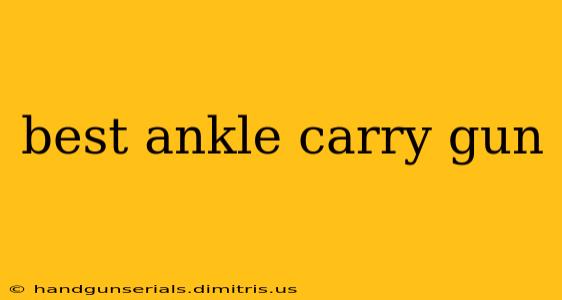Choosing the right ankle carry gun is crucial for personal safety and requires careful consideration of several factors. This isn't just about picking the smallest gun; it's about finding the optimal balance of concealability, firepower, reliability, and ease of access in a challenging carry position. This guide will help you navigate the complexities of ankle carry and select the best firearm for your needs.
Understanding the Challenges of Ankle Carry
Ankle carry presents unique challenges compared to other concealed carry methods. The limitations primarily revolve around:
- Concealability: The ankle is a relatively small area, limiting the size and type of firearm you can comfortably carry. Bulky weapons are impractical and uncomfortable.
- Accessibility: Drawing a firearm from an ankle holster requires specific training and practice. It's significantly slower than drawing from a waistband or shoulder holster.
- Comfort: Carrying a firearm on your ankle can be uncomfortable, especially during prolonged periods of standing or walking. The weight and potential chafing need careful consideration.
- Retention: The holster must securely retain the firearm to prevent accidental discharge or loss.
Factors to Consider When Choosing an Ankle Carry Gun
Before diving into specific firearm recommendations, let's examine the key factors influencing your decision:
1. Caliber: Balancing Power and Recoil
Smaller calibers like .22LR, .25 ACP, and .32 ACP offer increased concealability but compromise stopping power. Larger calibers like .380 ACP and 9mm offer greater stopping power but are more difficult to conceal and manage recoil. The optimal caliber depends on your individual needs and comfort level. A .380 ACP is often considered a good compromise between power and manageability for ankle carry.
2. Size and Weight: The Smaller, the Better (Usually)
Smaller firearms are essential for ankle carry. Look for compact and lightweight pistols that minimize bulk and discomfort. Oversized firearms will be noticeably uncomfortable and hinder mobility.
3. Reliability: Your Life Depends On It
Reliability is paramount. A malfunctioning firearm in a self-defense situation is unacceptable. Choose a firearm known for its dependability and consider the quality of the ammunition you'll be using.
4. Holster: Secure Retention and Ease of Access
The holster is as crucial as the firearm itself. A poorly designed holster can lead to accidental discharge, discomfort, or difficulty drawing. Seek out a high-quality ankle holster designed specifically for your chosen firearm. Consider features like retention straps and comfortable padding.
5. Training: Practice Makes Perfect
Effective ankle carry requires specialized training. Regular practice drawing and firing your firearm from an ankle holster is essential to develop proficiency and build confidence.
Recommended Types of Firearms for Ankle Carry
While specific models change with technological advancements, the general characteristics remain consistent. Generally, small semi-automatic pistols in calibers like .380 ACP or 9mm (with very compact models) are favoured. However, always prioritize reliable function and safe handling over the latest trends. Consult with experienced firearms instructors and conduct thorough research before purchasing any firearm.
Conclusion: Responsible and Informed Choice
Choosing the best ankle carry gun involves careful consideration of your individual needs, physical capabilities, and comfort level. Remember, safety and proficiency are paramount. Seek professional guidance from certified firearms instructors to ensure you are properly trained and equipped to utilize this method of concealed carry responsibly. Prioritize reliability and safe handling practices above all else.

